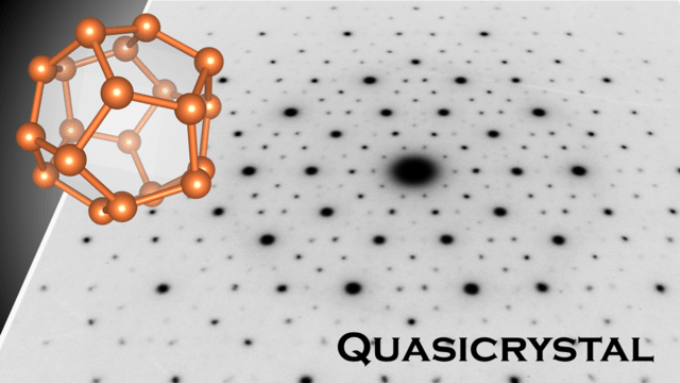Mar 29 2018
At low temperatures, remarkable things could take place, one of which is definitely superconductivity. Scientists have known this phenomenon, in which a solid’s electrical resistance falls to zero below a critical temperature, for a century. At present, it has found applications in industry and science. Students of chemistry and physics can even make their own levitating magnets by using superconducting alloys.
 Quasicrystal with five-fold rotational symmetry. An electron diffraction pattern of Al-Zn-Mg quasicrystal with a dodecahedron forming a Bergman-type cluster. (Image credit: Keiichiro Imura, Noriaki K. Sato, and Tsutomu Ishimasa)
Quasicrystal with five-fold rotational symmetry. An electron diffraction pattern of Al-Zn-Mg quasicrystal with a dodecahedron forming a Bergman-type cluster. (Image credit: Keiichiro Imura, Noriaki K. Sato, and Tsutomu Ishimasa)
Similar to most solids, the majority of the superconductors are crystalline—their atomic structures are made of periodically repeating cells. From the 1980s, the quasicrystal (QC), an alternative form of solid, has emerged prominent. Despite the fact that QCs have symmetry, they do not have repeated units like crystals. Such a lack of symmetry leads to the development of peculiar electronic structures. At present, for the first time, a research group headed by Nagoya University has unearthed superconductivity in a QC and has reported it in an article titled “Discovery of superconductivity in quasicrystal,” published in the Nature Communications journal.
The researchers analyzed an alloy of magnesium, zinc, and aluminum. The crystalline variant is noted to be superconducting. Yet, the structure of Al-Zn-Mg is reliant on the ratio of the three elements. The researchers discovered that the alloy’s properties were largely governed by Al.
According to Keisuke Kamiya, first author of the study, “When we reduced the Al content while keeping the Mg content almost constant, the critical temperature for superconductivity at first decreased gradually from ~0.8 to ~0.2 K. However, at 15% Al, two things happened: the alloy transformed into a quasicrystal, and the critical temperature plummeted to ~0.05 K.”
Such a very low critical temperature, only 1/20 of a degree above absolute zero, gives an account of the reason for the difficulty in achieving superconductivity in QCs. However, the QC alloy exhibited two archetypal properties of superconductors: the nearly total elimination of magnetic flux from the interior (called the Meissner effect) as well as a jump in specific heat at the critical temperature.
Superconductivity in traditional crystals has now been well perceived. At adequately low temperatures, the negatively charged electrons get over their mutual repulsion and attract each another, forming pairs known as “Cooper pairs.” These pairs merge into a Bose-Einstein condensate, a quantum state of matter with no electrical resistance. Yet, the attraction between the electrons is dependent on their interaction with the solid lattice, and traditional theory presumes this to be a periodic crystal, and not a QC.
The researchers took into account three probabilities for the origin of superconduction in the QC alloy, most extraordinary of them being “critical eigenstates”—distinctive electronic states only found near absolute zero. Although the electronic eigenstates localized in random solids but extended in crystals, the spatial extent of the critical eigenstates in QCs—which are neither random nor periodic—is ambiguous. Yet, the researchers rejected them depending on their measurements. This led the team to consider Cooper pairs, in either the less-common “weak-coupling” or the extended variety. As a matter of fact, the alloy was in close resemblance to a characteristic weak-coupling superconductor.
It’s interesting that the superconductivity of this alloy was not linked to its quasicrystallinity, but resembled that in so-called dirty crystals. However, the theory of quasicrystals also predicts another form of superconduction, based on fractal geometry in QCs. We believe there is a strong possibility that fractal superconductivity makes at least some contribution, and we would be excited to finally measure it.
Noriaki K. Sato, Corresponding Author